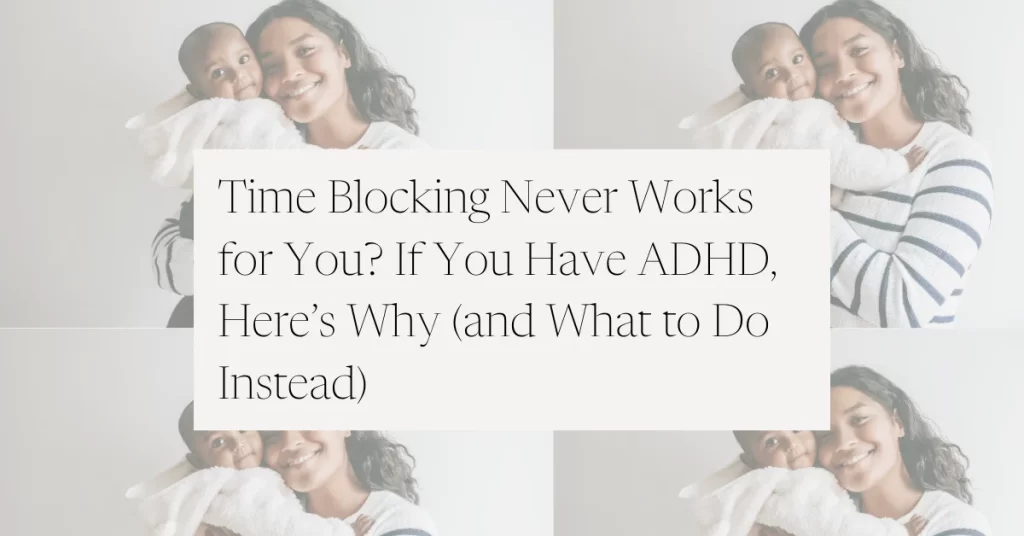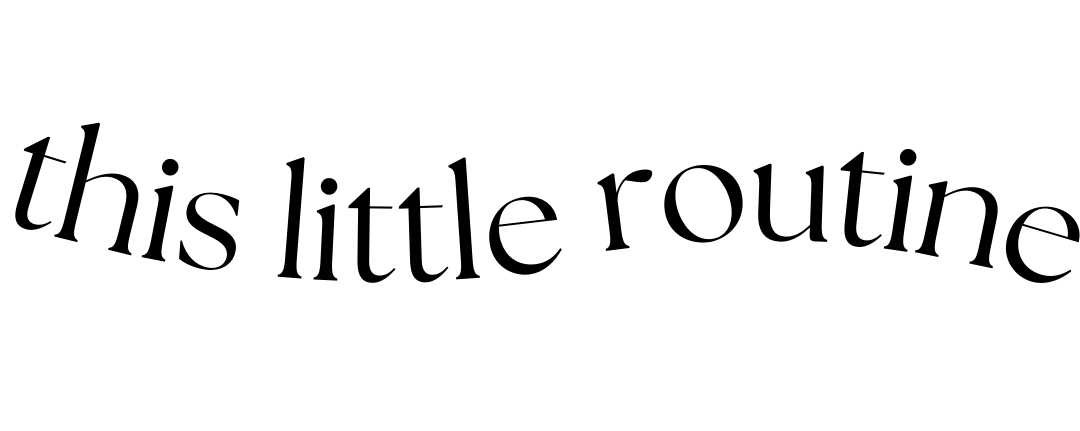
Has this ever happened to you? You spend an hour setting up the PERFECT time blocking for ADHD schedule. Every task has its own timed slot, arranged and color coded in Google Calendar. You sit back and think, This is it. This is the day I finally get my life together.
Then the time comes to actually follow it. And what do you do? Completely ignore it.
Maybe you suddenly feel exhausted. Maybe you convince yourself that just five minutes of doom scrolling won’t hurt. Or maybe you stare at the task on your schedule and think, Nope. Not happening.
And then the guilt sets in. Why do I do this? I made the plan. I know it works. So why can’t I just stick to it? If that sounds familiar, you’re not alone. I’m with you.
But time blocking for adhd CAN work- you just have to do it in a way that works for your brain. When it’s set up right, it can help you:
- Stop wasting time figuring out what to do next (one of the best ADHD time management tips!)
- Group tasks that makes them seem easier to follow through on (one of the simplest ADHD productivity strategies)
- Give yourself structure WITHOUT feeling trapped by it (a key part of ADHD focus techniques)

Basically, it’s not about forcing yourself to stick to a rigid schedule (spoiler alert: it won’t work for long!!!). Instead, this is a toolkit for finding flexible structure in a way that actually works. You’ll learn how to:
- Use replace a rigid schedule with flexible routines
- Plan around your energy levels instead of forcing productivity (ADHD time management tips that actually work!)
- Stay on track even when things don’t go to plan (a huge part of how to plan time with ADHD)
Let’s get into it!

1. Routines Work—Rigid Schedules Don’t
Problem: Sticking to a Detailed Schedule Feels Impossible
I’ve tried to follow strict schedules so many times, but they almost always fall apart. I’ve tried planning everything down to the minute, but the reality of parenting responsibilities, difficulty implementing ADHD productivity strategies, and life in general makes that impossible. There are too many moving pieces, too many interruptions, and plain old too many moments where I just don’t feel like doing what I planned.
But I’ve realized something: My days already have structure. They’re made up of routines.

Solution: Lean Into the Routines You Already Have
Routines aren’t about set schedules—they’re the small, predictable things that make life easier. And the best part? They can give you immediate wins, like a minty fresh mouth after brushing my teeth or silky skin after putting on moisturizer. Those things make me feel good right away, unlike, say, battling a toddler at bedtime.
When I step back and look at my day, I can see so many routines already happening:
- Morning routine (waking up, getting ready for the day, breakfast)
- Get-out-the-door routine (shoes on, last-minute chaos)
- Work transition routine (shifting into work mode)
- Nap time routine (diaper change, bottle, binky)
- After-school routine (coats off, washing hands, snack, decompressing)
- Evening routine (dinner, bedtime for the kids)
- Bedtime routine (take off makeup, shower, put on pjs, journal)
These moments already give my day structure. I don’t need to follow a set schedule- I just need to lean into the flow that’s already there.

How to Apply This:
- Recognize the routines already in your day. Look at how you transition between morning, work, school pickup, bedtime, etc. You probably already have routines in place that help with ADHD time management. You just might not realize it!
- Use your routines as guides for how to plan time with ADHD. Instead of saying, I’ll work on this task at exactly 10:00 AM, try:
- After I finish my morning routine, I’ll start my work block.
- After the kids go to bed, I’ll do my bedtime routine
- Prioritize immediate wins in your routines. Choose small actions that make you feel good and set you up for success. For me, it’s brushing my teeth and moisturizing. It’s small, but it makes a big difference. Kids can be a tough crowd sometimes, so you know what? A win is a win! Take it and run! Small wins like these can reinforce ADHD productivity strategies.

The Bottom Line:
The bottom line is, you don’t need a perfect schedule to stay on track—you just need to lean into the natural flow of your day. When you focus on routines instead of rigid blocks of time, things feel smoother, and you’re not constantly fighting your own brain.
Tiimo is one of the best ADHD time management tools I’ve found.
2. Plan Around Energy, Not the Clock
Why This Is a Struggle:
Our brains aren’t robots built for nonstop productivity, and honestly, that’s a good thing! Some moments, we’re in hyperfocus mode and other times, we’re staring at a task, knowing we SHOULD start but feeling completely drained.
It’s not about motivation or willpower—it’s just how our energy ebbs and flows throughout the day.
That’s why ADHD focus techniques like time blocking can be both powerful AND tricky. If we schedule the wrong task at the wrong time, we end up frustrated and avoiding it. But when we work WITH our energy levels instead of against them, time blocking becomes a tool that actually helps instead of something we try to avoid.

A Smarter Way to Time Block:
Instead of forcing yourself into a strict schedule that doesn’t fit, try this little experiment:
For the next few days, start noticing:
- When do you feel most focused and alert?
- When do you usually slow down and need a break?
Once you see a pattern, you can plan your time blocks around your energy instead of fighting it. This is one of the most important ADHD time management tips.

Sort Your Tasks into Three Categories:
For example:
- High energy tasks (work, running errands, decision-making)
- Low energy tasks (housework, meal planning, paperwork)
- Energy boosters (snack, fresh air, music, friends)
Match Your Schedule to Your Energy Levels:
- Do high-energy tasks when you have the most energy.
- Plan energy boosters before you hit a slump.
- Save low-energy tasks for when you’re running on empty.
For example, I know that right before dinner, my patience is almost gone. That’s NOT the time to tackle something physically and mentally draining, like cleaning up the play area after my kids have spent the afternoon emptying their toy bins. Instead, I plan that clean up earlier in the day, maybe after my toddler’s nap, when I have more energy. Plus, getting it done then actually gives me a little boost because a clean space feels good. Time blocking for ADHD means taking into account your natural energy levels.

How to Apply This:
Let’s say you’ve tracked your energy and noticed your best focus time is mid morning, between school drop off and lunch (same!!). That’s when you’d schedule tasks that require the most energy—work, running errands, making decisions.
By early afternoon, you feel sluggish. Instead of pushing through, you plan an energy boost—a yummy snack, a yoga session with the kids, or stepping outside for some fresh air. Then, you get back into things with a lower energy task.
By the time dinner rolls around, your energy is running low low low. This is when you do the easy stuff—paperwork, playing doctor with the kids (bonus: you get to lie down during your check-up, haha).

Instead of fighting your energy, you’re working with it. No more forcing productivity—you’re designing a routine that does the heavy lifting for you. It’s time blocking for ADHD done the right way for you.
3. Big Blocks, Not Tiny Time Slots
Why This Is a Struggle:
ADHD brains don’t thrive on super detailed plans—we need flexibility within structure. When every minute is assigned a task, there’s no room for the natural shifts in energy, focus, or, unexpected chaos that comes with life.

Solution: Use Broad Time Blocks
Instead of cramming your day into small, set slots, think big, flexible chunks of time:
- Morning = Work Tasks
- Early Afternoon = Errands & Appointments
- Evening = Family + Relaxation
This keeps your schedule structured WITHOUT making you feel boxed in. Plus, it makes digital planners like Google Calendar way easier to stick with.

How to Apply This:
1. Pick 3 big time blocks that match your day.
2. For each block, list 2-3 priority tasks to choose from.
3. Use routines, alarms or visual cues to transition between blocks.
This way, you still have a plan—but it works WITH your ADHD brain, not against it.
4. When Kids Derail Your Plans (Because They Will)

Why This Is a Struggle:
You sit down to get going on your to do list, and just as you get started, someone needs a snack or your preschooler MUST wear their Elsa dress RIGHT NOW. Trying to follow a set, minute by minute schedule with kids? Total disaster.
But we still need structure. Otherwise, the day feels like one long game of whack-a-mole. Want to know the trick? Loosening up the schedule so it bends without breaking.
Time Blocking for ADHD: Loose Daily Sections Instead of Hourly Schedules
Instead of mapping out your day hour by hour, break it into big, flexible sections that flow with your family:
- Morning = work and school drop off
- Early afternoon = errands + decompress after school
- Late afternoon = playtime
- Evening = dinner, family time, bedtime

Now, if something interrupts your plans, you don’t need to adjust every time slot. The structure is there, but there’s breathing room.
How to Apply This:
- Define 3-4 sections for your day based on when you naturally shift activities.
- List a few key tasks for each section so you have choices.
- Expect interruptions and go along with them. When plans change, you’re adjusting within a flexible framework, not starting over from scratch.
The goal isn’t a perfect schedule, it’s to find a rhythm that works for real life.
5. A Reset Button for When the Day Goes Off Track
Why This Is a Struggle:
Ever have one thing go wrong- maybe you get stuck in a doom scroll or the kids wake up sick- and suddenly, the whole day feels like a lost cause? That’s all-or-nothing thinking, and ADHD brains love it.

But here’s a thought: A bad MOMENT doesn’t have to mean a bad DAY. The problem isn’t getting off track—it’s not having a way to reset.
Solution: Build in a Reset Button
Instead of running around crazy, trying to catch up (which only leads to frustration), just move to the next block of your day. Without guilt and without feeling bad. Just a fresh start.

When something takes longer than planned, jump into the next task instead of rewriting your whole schedule. Is dinner running late? Skip the next block and move into bedtime. Your schedule is a tool, not a test you can fail.
Here are some ideas how ChatGPT can help you to reset.
How to Apply This:
- Create a reset ritual. Take a deep breath, stretch, or do a five-minute tidy-up—something small that tells your brain “okay, I’m moving on.”
- When a block doesn’t go as planned, skip it and keep going. No doubling up, no making up for lost time. Avoid the stress where you can. Just pick up where you are.
- Remind yourself: One rough block DOES NOT EQUAL a ruined day. ADHD brains love a dramatic narrative, but you get to rewrite it.
A reset button gives you permission to keep going—because time blocking for ADHD is about progress, not perfection.

Conclusion: Structure That Works for Your Brain
Time blocking isn’t about cramming your day into a rigid schedule—it’s about creating a flow that works WITH you and your routines. The goal is to create a rhythm that caters to your energy levels and does the heavy lifting for you.
Pick one thing from this toolkit to try this week. Maybe it’s using bigger time blocks, setting up loose daily sections, or adding a reset button when the day goes off track. If you have a friend who needs this post, send it to her!
Because the best schedule is the one you’ll actually use. And the more you shape it around how your brain really works, the more it will finally start working for you.
This post was all about time blocking for ADHD.
